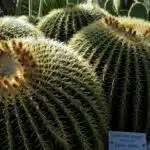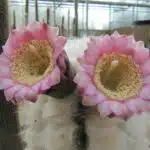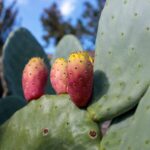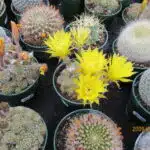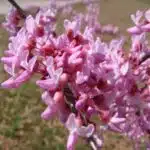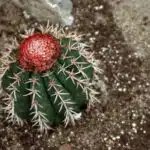The Eastern Prickly Pear Cactus is a vibrant and hardy gardener’s best friend – like a loyal companion, it will stay by your side through thick and thin. Growing and caring for this cactus is not only rewarding, but also relatively easy! With the right knowledge and maintenance, you can have your own Eastern Prickly Pear Cactus thriving in no time.
As an experienced botanist, I have seen first-hand how the Eastern Prickly Pear Cactus can bring life to any garden or outdoor space. Not only are they incredibly resilient plants, they are also incredibly beautiful. They come in many varieties with unique color patterns, from yellows and oranges to pinks and purples – something for everyone! Each cactus has its own unique characteristics that make them special.
Caring for a prickly pear cactus does require some expertise, however. It’s important to know how to properly maintain it so that it can remain healthy for years to come. In this article, I will provide essential tips on how to grow and care for the Eastern Prickly Pear Cactus. With my guidance, you’ll be well on your way to having a lush garden full of these majestic plants!
Choose A Suitable Location
When selecting a location for an Eastern Prickly Pear Cactus, it’s important to consider the plant’s needs. Special attention should be given to the amount of sunlight the area receives and how well-draining the soil is. While Eastern Prickly Pears can tolerate some shade, they generally need at least six hours of direct sunlight per day in order to thrive. Additionally, they require loose, gritty soil with good drainage. Sandy soils are ideal, but a mix of sand and organic matter can also work. It’s best to avoid clayey or heavy soils that don’t drain well.
When planting an Eastern Prickly Pear Cactus in a garden or pot, it’s also important to consider its ultimate size and shape. This cactus grows best when spaced about two feet apart. When planted too closely together, it can become overcrowded and suffer from various diseases and pests. Additionally, Eastern Prickly Pears have shallow roots that can spread far from their base of the plant and may need extra space to accommodate them.
Placing an Eastern Prickly Pear Cactus in an appropriate location is essential for its long-term health and success in your garden. With careful consideration of its needs and adequate space allowance, this hardy cactus will bring years of joy with its attractive blooms and captivating pads! Now let’s look at how to ensure optimal soil conditions for your Eastern Prickly Pear Cactus so it can flourish in its new home!
Planting And Soil Requirements
When it comes to planting and caring for eastern prickly pear cactus, it is important to get the environment just right. Just like a tailor-made suit, the location, soil requirements and fertilizer needs can be tailored to ensure maximum growth. Here are some tips to help you get started:
Firstly, if you have a sunny spot in your garden with well-draining soil, this will be the ideal place to plant your eastern prickly pear cactus. If your soil is heavy or clay-like, consider mixing in some compost or sand to help improve drainage.
Secondly, when planting your prickly pear cactus make sure that you use a potting mix specifically designed for cacti. This will provide optimal drainage and allow the roots of your cactus to stay dry and healthy. Additionally, add some slow-release fertilizer into the potting mix before planting – this will give your cactus an additional boost of nutrients during its initial growth period.
Finally, keep in mind that cacti need very little water so water sparingly until you see signs of new growth – overwatering can lead to root rot and other issues that could prove fatal for your plant.
Water And Fertilizer Needs
Watering and fertilizing a prickly pear cactus can be like trying to fill a bottomless pit—it often feels like you can never do enough. In order for your cactus to thrive, it’s important to understand its needs and provide them accordingly.
The key factor in providing your cactus with the optimal water and fertilizer needs is soil type. Prickly pears grow best in sandy loam soils that are well draining and low in nutrients. Because these soils don’t retain water very well, you’ll need to supplement with more frequent watering than other types of plants require. Water deeply whenever the top inch of soil is dry, making sure to keep the soil evenly moist but not soggy or wet. During periods of extreme heat or drought, you may need to increase the frequency of your watering schedule even further.
As far as fertilizer requirements go, this type of cactus prefers light applications throughout the growing season—aim for once every three weeks or so during spring and summer. Use a balanced liquid fertilizer diluted to half strength for best results, and avoid using too much nitrogen as it can cause root rot. As always when dealing with any type of plant care, err on the side of caution—over-fertilizing can quickly cause more harm than good!
By providing your prickly pear cactus with the right combination of water and fertilizer, you’ll be setting yourself up for success in creating a healthy environment where they can thrive!
Sunlight Requirements
When it comes to the cultivation of eastern prickly pear cactus, the most important factor to consider is the plant’s sunlight requirements. This cactus grows best in full sun, meaning that it needs direct exposure to sunlight for at least 6 hours a day. If not given enough sunlight, the plant may not be able to photosynthesize properly and could experience stunted growth or even die. Therefore, it’s essential to ensure that your eastern prickly pear cactus has access to plenty of direct sunlight each day.
To help your eastern prickly pear cactus thrive, you should also make sure that it gets some shade during the hottest part of the day. This will help protect its delicate body from becoming dehydrated and ultimately dying due to intense heat exposure. Additionally, if you live in an area where temperatures reach extreme highs during summer months, be sure to find a way to provide your prickly pear cactus with some protection from harmful UV rays. A simple canopy or shading cloth can go a long way towards ensuring its optimal health and growth.
The key takeaway here is that eastern prickly pear cacti require plenty of direct sunlight in order for them to thrive. However, too much exposure could be detrimental for them as well, so it’s important to strike a balance between providing enough light and protecting them from excessive heat levels. With care and attention, you’ll be rewarded with a healthy and beautiful addition to your garden! Transiting now into planting this wonderful species…
How To Plant Eastern Prickly Pear Cactus
When planting Eastern Prickly Pear Cactus, it’s important to remember the following guidelines:
First and foremost, select a pot with adequate drainage. Clay or plastic pots are ideal, as they’ll help ensure proper drainage of excess water. Additionally, be sure to use a potting soil that’s formulated for cacti and succulents. This will help promote healthy growth and prevent root rot.
When putting your cactus in its new home, there are several things to keep in mind:
- Make sure the pot is deep enough so that the roots of the cactus can spread out properly.
- Plant at the same depth as it was originally grown.
- Water lightly after planting and wait until the soil has dried before watering again.
- Place your cactus in an area where it’ll receive plenty of sunlight and air circulation.
These simple steps will help ensure that your Eastern Prickly Pear Cactus thrives! With proper care and attention, this beautiful plant can bring years of enjoyment to any space. Now that you have planted your Eastern Prickly Pear Cactus, it’s time to learn about pruning and maintenance – key elements of keeping this unique plant looking its best!
Pruning And Maintenance
Pruning and maintenance of the Eastern Prickly Pear Cactus is critical to its growth and health. A gardener must handle these cacti with care, for their spines can be sharp and painful! Like a sculptor with a chisel, a skillful pruner can shape these plants into various forms. Here are some tips on how to properly maintain this cactus:
Firstly, it is important to remove any dead flowers or fruits from the plant to promote healthy growth. Likewise, it is necessary to trim off any rotten or dried-out parts of the stem to avoid attracting pests that could cause further damage. Additionally, excess shoots should be removed as they mature in order to ensure more abundant blooms in the future.
On top of that, the Eastern Prickly Pear Cactus needs regular watering and fertilizing during its growing season. To keep the soil moist but not waterlogged, use an organic mulch such as compost around the base of the plant; this will also help retain moisture in dry spells. A diluted liquid fertilizer should then be applied monthly while actively growing.
Finally, it’s always beneficial to rotate your plant every few months so that all sides of it get equal sun exposure. Doing so will help prevent uneven growth and encourage healthier development overall – key elements for achieving a lush garden display!
Propagating Eastern Prickly Pear Cactus
While Eastern Prickly Pear cacti are low-maintenance plants, propagating them can be a rewarding experience for anyone looking to expand their garden. For those willing to take the plunge and try their hand at growing a new plant, here’s how to get started.
Propagation of Eastern Prickly Pear is best done from cuttings, as seeds are difficult to come by. Cuttings taken in spring or summer will root more easily than those taken in autumn or winter. The cutting should be at least six inches long and have no fewer than three joints. Remove the lower leaves and let the cut end dry out and callous over before planting. Plant the cutting in porous soil with some added organic matter such as compost. Water thoroughly every few days until the cutting has rooted, then reduce watering to once weekly during dry periods.
Fertilize sparingly; too much fertilizer can damage the roots of young plants, causing them to rot or die off prematurely. Once established, Eastern Prickly Pear can be pruned back if need be; trimming away any dead or diseased parts of the plant will help it thrive for years to come. With patience and proper care, you too can grow your own Eastern Prickly Pear cactus from cuttings!
Troubleshooting Common Problems
Although the Eastern Prickly Pear Cactus is generally an easy-to-care-for plant, it can occasionally run into some problems. As a specialist in botany and gardening, I’m here to help you troubleshoot these common issues.
Let’s start off with some of the more minor issues, such as spots on the leaves or discoloration. This could be due to too much direct sunlight or not enough water – check to make sure your cactus isn’t getting scorched by harsh sun rays, and that you are giving it enough hydration to keep it healthy!
On the other hand, if you find that your cactus is wilting or drooping despite adequate watering, this may be a sign of root rot. It’s important to remove any affected areas before they spread and replace them with fresh soil and new plants if needed. Remember: healthy roots mean a healthy cactus!
Taking proper care of your Eastern Prickly Pear Cactus can prevent many of these issues from occurring in the first place. So don’t forget to give your cacti plenty of sun, water, and good drainage – that way they’ll stay happy and healthy for years to come!
Controlling Pests And Diseases
Although controlling pests and diseases can be tricky for Eastern Prickly Pear Cactus, it’s an essential part of the growing process. As a specialist in botany and gardening, I’m here to tell you there is hope! With proper knowledge, techniques, and a bit of patience, you can successfully maintain healthy plants that are free from disease.
To begin with, let’s tackle the dreaded pests. Thankfully, most outdoor cacti are not prone to any major pest infestations. However, if you notice any bugs on your plant or nearby soil, take action right away. The simplest way to combat pests is prevention; keep your plants clean and regularly inspect them for signs of infestation. Additionally, using natural insecticides such as neem oil can help deter pests from invading your garden.
Next, let’s discuss disease control. Eastern Prickly Pear Cactus can suffer from several common diseases including root rot and fungal infections. To avoid these issues altogether, provide your plants with adequate drainage and avoid overwatering them at all costs. If you do find that one of your plants is diseased, removing the affected area will greatly reduce the risk of infection spreading throughout your entire garden. Furthermore:
•tProper cultural practices: otCrop rotation otSanitizing tools •tBiological methods: otEncouraging beneficial insects otIntroducing natural predators
By following these tips and tricks for preventing and controlling pests and diseases in Eastern Prickly Pear Cactus gardens, you’ll be able to foster healthy plants that are safe from harm. With regular care and attention to detail, it won’t be long before they’re ready to harvest!
Harvesting Eastern Prickly Pear Cactus
Harvesting Eastern Prickly Pear Cactus is a rewarding experience. It’s as if you’ve unearthed a hidden treasure – the beautiful, vibrant fruits of your labor! Here are three tips to get you started:
- Don’t forget to wear gloves and protective clothing – this plant has sharp spines that can cause injury!
- When harvesting the fruit, gently twist it off the stem. If it doesn’t come off easily, leave it for another day.
- Be sure to cut away any brown or discolored spots on the fruit before using or storing it.
As a specialist in botany and gardening, I recommend harvesting the Eastern Prickly Pear Cactus fruits when they are fully ripe and ready – this will ensure they have the best flavor and texture. The fruits can be eaten fresh or used in recipes such as jams, jellies, and sauces. Once harvested, store them in an airtight container in the refrigerator for up to two weeks.
Harvesting Eastern Prickly Pear Cactus is a great way to make use of this amazing plant! Not only do you have access to its delicious fruits, but you can also enjoy its unique beauty for years to come. Now that we have harvested these cacti, let’s discuss what else we can do with their prickly pear fruits!
What To Do With Prickly Pear Fruits
Once the Eastern Prickly Pear Cactus has been harvested, it’s time to figure out what to do with the fruits! There are a variety of uses for these succulent, sweet fruits. From jams and jellies to garnishes and beverages, there is a lot of potential in the prickly pear fruit.
To start off, let’s focus on the most common use for prickly pears – jams and jellies. The process for making these is relatively simple – all you need is some sugar, water, and lemon juice. Boil everything together until it reaches a thick consistency and your jam or jelly is ready! Prickly pears can also be used as a topping for cakes, tarts, and other desserts. Simply mix a few tablespoons of sugar with some diced up prickly pear pieces and you have a delicious topping that will add flavor to any dish.
The next option is infusing drinks with prickly pear fruit. This is an easy way to make custom cocktails or mocktails that will impress your friends! All you need to do is combine some fresh prickly pear fruit with vodka or rum and let it sit overnight. Strain the mixture into a glass before serving and you’ll have an exotic drink that everyone will love!
No matter how you choose to use them, Eastern Prickly Pear Fruits are sure to add sweetness and flavor to any dish. With so many options available, why not give them a try today?
Uses For Prickly Pear Pads
The prickly pear pads are a unique feature of the eastern prickly pear cactus. They have multiple uses and can be harvested for a variety of purposes. Here are some ways you can use the pads:
• As a food source: Prickly pear pads can be peeled, cut into strips, and cooked as a vegetable dish. They can also be made into jams, jellies, and sauces.
• As an herbal remedy: Prickly pear pads have anti-inflammatory properties that make them useful in treating skin irritations and infections. Additionally, they contain important vitamins and minerals that can help boost your immune system.
• For landscaping: Prickly pear pads are often used in landscaping projects to add texture and color to gardens or outdoor spaces. The unique shape of the pad makes it perfect for creating interesting displays or focal points in the garden.
• In crafts: Prickly pears can be used in craft projects such as wreaths, garlands, flower arrangements, and mosaic wall art. You can also use them to create decorations for holidays such as Christmas or Easter.
• As seed starters: The seeds from prickly pears can be planted in pots or containers to start new plants indoors or outdoors. This is an easy way to propagate more cactus plants without having to purchase them from a nursery.
These are just some of the many uses of prickly pear pads; with a little creativity, you may find even more ways to make use of these fascinating plants! Now that you know how versatile prickly pears are, let’s explore some interesting facts about the eastern prickly pear cactus…
Interesting Facts About Eastern Prickly Pear Cactus
The eastern prickly pear cactus is an iconic desert plant that has been used for centuries in various parts of the world. Its unique characteristics have made it popular among gardeners and botanists alike, but many are unaware of some interesting facts about this plant. Let’s explore some of these fascinating facts:
Firstly, eastern prickly pear cacti have a surprisingly long lifespan. They can live up to 100 years if properly cared for, making them one of the longest-living plants in the world. Secondly, they are incredibly resilient; they can survive extreme temperatures ranging from -20°F to 120°F. Thirdly, they are drought-tolerant and can store water in their stems or pads for months at a time, allowing them to survive extended periods without water or rain. Finally, these plants produce large yellow flowers that attract native pollinators like bees and butterflies.
These fascinating traits make the eastern prickly pear cactus an excellent choice for any gardener looking to add a unique and low-maintenance plant to their landscape. With its long lifespan and hardy nature, it’s no wonder why this desert dweller has become such a popular choice among gardeners worldwide.
Tips For Growing Eastern Prickly Pear Cactus
Cultivating cacti can be a challenge, but with the right tips, you can successfully grow and care for eastern prickly pear cactus. From proper soil selection to adequate sunlight, here are some top tips to ensure successful growth of this popular succulent.
Firstly, select the perfect potting soil that is specifically designed for cacti. A good soil should be light and quick-draining, ensuring adequate air circulation and water retention. Secondly, position your eastern prickly pear in an area that receives at least six hours of direct sunlight every day. This will help promote healthy growth and blooms as well as prevent rot due to over-watering.
Finally, when it comes to watering your plant, moderation is key. Eastern prickly pears do not require frequent watering; rather they prefer their soil to dry out completely between waterings. Over-watering can lead to root rot and various other issues. So make sure you use a moisture meter or simply stick your finger into the soil before giving your plant a drink!
Safety Considerations When Handling Eastern Prickly Pear Cactus
The eastern prickly pear cactus is a unique and striking addition to any garden. Yet, when handling this plant, it’s important to take a few safety considerations into account. As a botanist and gardener, I’d like to share some of my tips for handling the eastern prickly pear cactus safely and with ease.
First off, it’s best to wear gloves when handling the eastern prickly pear cactus – or any other type of cactus – as it can have sharp spines which can easily penetrate skin and cause irritation. Also, be sure not to touch your face while wearing gloves that have touched the cactus; this is because the spines may still be present on the gloves.
When transplanting or repotting an eastern prickly pear cactus, use a pair of tongs or pliers instead of your hands so that you don’t accidentally get pricked by its spines. It’s also important to keep in mind that this type of cactus does not like to be disturbed too often, so only repot when absolutely necessary. Additionally, although this plant is drought-tolerant, be sure to water it regularly as overwatering could lead to root rot.
Overall, growing Eastern Prickly Pear Cacti requires some special considerations regarding safety precautions – but with these helpful tips in mind, you can enjoy caring for this lovely plant with ease!
Frequently Asked Questions
How Long Does It Take For Eastern Prickly Pear Cactus To Mature?
Do you know how long it takes for an eastern prickly pear cactus to mature? It’s an important question to ask if you’re thinking of growing one in your garden. As a specialist in botany and gardening, I’d like to share my knowledge on this subject.
Maturation of a prickly pear cactus will depend on a few factors such as the environment, soil quality, and level of care. Generally speaking, it usually takes two to three years for a new prickly pear cactus to reach maturity. The growth rate can be accelerated with ideal environmental conditions and proper care.
To ensure that the eastern prickly pear cactus thrives, provide it with plenty of sunlight and water during its growing season. Planting in well-draining soil is also necessary as these plants prefer dry conditions over wet ones. Prune off any dead or damaged parts as needed and fertilize occasionally during its growing period for best results.
With the right care and adequate sunlight, you can enjoy watching your eastern prickly pear cactus grow into a healthy, mature plant.
How Often Should Eastern Prickly Pear Cactus Be Fertilized?
Eastern prickly pear cactus is a hardy and drought-tolerant cactus, making it an ideal choice for gardeners looking for an easy-to-care-for plant. However, in order to keep your eastern prickly pear cactus healthy and happy, it’s important to fertilize them regularly.
Fertilizing your eastern prickly pear cactus should be done at least once every three months in the spring and summer. When fertilizing, use a balanced fertilizer that is high in phosphorus and potassium. It’s also important to use a diluted fertilizer solution; too much fertilizer can cause damage to the roots of your cactus. Also make sure you water thoroughly after fertilizing.
As far as frequency goes, you should fertilize more frequently if your soil is particularly poor or if you live in an area with hot summers. In these cases, applying fertilizer every two months should provide enough nutrients to keep your cactus healthy and thriving. Remember, with any type of fertilizer application, it’s always better to err on the side of caution when adding nutrients; too much can do more harm than good!
It’s also important to check the soil around your eastern prickly pear cactus regularly to make sure that it isn’t too dry or nutrient deficient. If the soil looks like it needs some help with moisture or nutrients, then feel free to apply a bit more fertilizer or water accordingly. Regular maintenance will ensure that your eastern prickly pear cactus continues to look great for years to come!
What Is The Best Way To Remove Spines From The Pads Of Eastern Prickly Pear Cactus?
Working with Eastern Prickly Pear Cactus can be a challenge due to its spines. However, with the right technique and equipment, it’s possible to remove them safely and efficiently. Here we’ll look at the best way to remove spines from the pads of Eastern Prickly Pear Cactus.
First off, it’s important to note that removing spines from this cactus should be done carefully. The spines are sharp and can easily become embedded in clothing or skin if not handled correctly. To prevent any accidents, you should wear thick gloves and use tweezers or small pliers when attempting to remove them.
The next step is to gently pull the spine away from the pad using your tools. It’s important to take your time here as pulling too hard can damage the pad. Once you have successfully removed the spine, you can discard it in an appropriate container such as a sealed jar or bag.
To ensure that no more spines end up on your hands or clothes during removal, it is recommended that you:
- Use a brush or vacuum cleaner on the entire plant after each harvest;
- Refrain from touching other areas of the plant while removing spines;
- Wear protective gloves whenever handling Eastern Prickly Pear Cactus;
- Keep your workspace clean and free of debris.
By following these steps, you can ensure that all spines are removed safely and efficiently from Eastern Prickly Pear Cacti without causing any harm either to yourself or to the plant itself. With proper care and attention, these plants will thrive for years to come!
Is It Safe To Eat The Fruits Of Eastern Prickly Pear Cactus?
The Eastern Prickly Pear Cactus is an incredibly hardy and easy to care for plant. It is also a plant with some unique features, one of which are its edible fruits. So the question remains: Is it safe to eat the fruits of Eastern Prickly Pear Cactus? The short answer is yes, however there are some important considerations you should take into account before consuming any wild foraged fruit.
Firstly, it’s important to recognize that the spines on this cactus can be quite painful if touched without proper protection, so taking precautions when harvesting is essential. If you do choose to harvest from wild populations, make sure you wear thick protective gloves and long sleeves in order to avoid being hurt by the spines. Additionally, be sure to only pick mature fruit that has a deep purple colour and a slight give when pressed with your fingers – otherwise the fruit will not be ripe enough for eating.
Once harvested, the flesh of these fruits can be eaten raw or cooked in a variety of ways. The taste is sweet and pleasant and they are a great source of vitamins A, B6 and C as well as dietary fibre. As such, they make an excellent addition to salads or smoothies as well as being useful in desserts like pies or jams.
In summary then, yes it is safe to eat Eastern Prickly Pear Cactus fruits provided that you take proper precautions when harvesting them and ensure they are fully ripe before consumption. With their delicious flavour and nutritional benefits they can make an excellent addition to your diet!
Can Eastern Prickly Pear Cactus Be Grown Indoors?
Eastern prickly pear cactus (Opuntia humifusa) is a popular species of cacti for gardeners and home growers. It is native to the Eastern United States and thrives in hot, dry climates. But can this cactus also be grown indoors?
The answer is yes, eastern prickly pear cactus can be grown indoors with some extra care. To create a suitable environment for this species of cactus, it is important to give it as much light as possible. An east or west-facing window is ideal, but even artificial lighting such as fluorescent bulbs can do the trick. Be sure to keep the plant at least 12 inches away from the window so it does not get too hot or cold.
In addition to providing adequate light, eastern prickly pear cactus needs good drainage and soil that will not become soggy when watered. A commercial potting mix with added pumice or perlite works well for this purpose. The soil should also be slightly acidic with a pH between 5 and 6.5; if needed, you may need to adjust the pH with lime or sulfur before planting. Finally, water your eastern prickly pear cactus only when the soil is completely dry – overwatering can lead to root rot and other problems.
With these simple steps, you can successfully grow eastern prickly pear cactus indoors and enjoy its unique beauty in any season!
Conclusion
The Eastern Prickly Pear Cactus is a beautiful and hardy plant that can bring color and life to any garden. It takes some effort to care for this cactus, but it is well worth the effort. With regular fertilization, proper pruning and spines removal, and adequate sunlight, this cactus will thrive in your garden.
It was a coincidence that I found out about the edible fruits of the Eastern Prickly Pear Cactus. This discovery has made me appreciate this plant even more since now I know that not only does it look stunning in my garden, but it also provides me with delicious fruits to enjoy.
In conclusion, if you are looking for an exotic and unique addition to your garden, then the Eastern Prickly Pear Cactus should be high on your list of plants to consider. With proper care, its beauty will be rewarded with an abundant yield of fruits every season!




